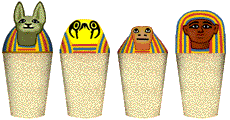Ancient Egypt Fan
![]()
Mummification
Ancient Egypt is a source of fascination for many people and if you ask most people to list some features which interest them, mummification will come high on the list. Why is this? Well most of us no doubt will admit to a morbid side to ourselves that is fascinated with death because it is a process that we will all experience at some point in the future. Indeed death and mummification forms a central theme in many books, stories and horror films, where our imagination can run riot. The recent films The Mummy and The Mummy's Return are examples of this, but how accurate do such films and stories portray this ancient art? The short answer to this question is not very and we are back to imagination again and the demand for entertainment at the expense of an accurate account of ancient customs. This poetic license is fine as far as it goes but what about those of us who want a more accurate account of what this procedure involved? Well not to worry because there are many accurate accounts recorded by such notable Greek historians as Herodotus and Diodorus Siculus.
In many ways it is difficult for us to look at the whole question of life and death and to see it in the same context as the Egyptians did. We have to try and discard for the duration our own more recent Judeo/Christian beliefs to get to the truth as they saw it and this is not an easy exercise you will agree.
Not everyone in ancient times was given the option of being mummified. Only these close to the Pharaoh or those wealthy enough to be in a position to pay for this lavish treatment were considered. It was a mark of a person's esteem as to how he could provide for his own afterlife.
The standard period of embalming lasted seventy days in all. Firstly, the lungs, liver, stomach and intestines were removed and placed in separate vessels called canopic jars.

From left to right
Originally all organs were placed in one jar but this practice changed after the 4th Dynasty. The heart was the only organ to be left within the body, contrary to popular belief as it was considered to be the seat of reason, emotion, memory and personality as we attribute to the brain today. Dry natron was then used on the body, both internally and externally for forty days, after which the body was washed, packed with linen and resin and finally wrapped with linen bandages. These constitute the main elements of mummification but there were slight variations introduced depending on the era we are talking about. For example during the Middle Kingdom the brain was extracted through the nose, and again depending on the era facial features were adorned by funerary masks in earlier times as opposed to painted wooden panels Faiyum portraits during the Roman period. When Egyptian society converted to the Coptic Christian religion, mummification began to be associated with the old pagan ways and was finally denounced.

Anubis
Anubis the jackal-headed deity the watcher of graveyards and conductor of souls was the god of mummification. He was able to restore life to the murdered body of Osiris by embalming his corpse and wrapping it in linen. Osiris was the god of the dead and ruler of the underworld.
As well as fulfilling the needs of the Egyptians as regards belief, duty and ritual, mummification has had some positive spin off value to our own society today. Thanks to this ancient procedure, we are now able, with the aid of modern techniques and equipment, to observe these mummified corpses and to learn a great deal about the way they lived, the state of their health, how they tried to combat diseases and many other interesting facts. This in the end can only help to increase our store of knowledge and put us in a better position to try and understand more fully this great civilisation.
![]()
Last revised 25th Nov 2001
